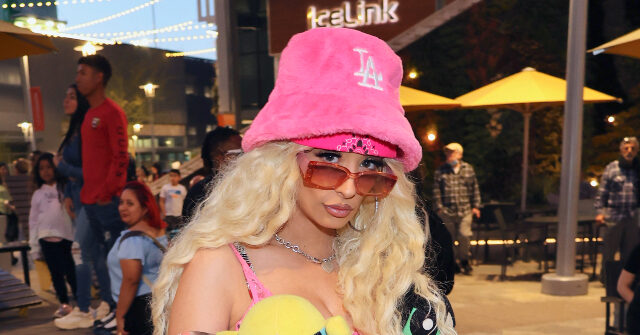Indie singer Loomis found herself at the center of controversy after delivering a less-than-stellar performance of the national anthem at the Free & Equal Presidential Debate. The event, held in Los Angeles, featured three third-party presidential candidates: Chase Oliver from the Libertarian Party, Dr. Jill Stein representing the Green Party, and Randall Terry from the Constitution Party. Loomis’s rendition of “The Star-Spangled Banner” quickly derailed when her voice cracked mid-song, leading her to utter a curse word and request a do-over. This moment of panic drew attention not just for its awkwardness but for revealing the pressures that come with singing such a significant song in a public setting.
Loomis’s plea for a reset—“I fucked it up, I fucked it up, can I go back please?”—only added to the chaotic atmosphere of the performance. Unbeknownst to her, the singer was live on stage, and the production crew indicated there would be no chance for a recast. Despite her initial confusion, she composed herself and continued to finish the anthem, albeit in a less-than-flawless state. This display sparked a whirlwind of reactions online, with many viewers mocking her performance or expressing sympathy for the difficulties involved in singing the national anthem, especially in front of a large audience.
After the incident, Loomis spoke with TMZ to clarify her perspective on what transpired during the performance. She expressed her surprise at realizing that the performance was live and her feelings of nervousness that had been building up since she was a child. Loomis stated that she had always found the idea of singing the national anthem intimidating, given the solemnity with which the audience typically approaches it. Reflecting on her long-standing apprehension, she noted, “Since I was a little girl, I always said I don’t want to sing the national anthem, it’s like the scariest thing to me ever because everyone’s all standing up so serious and everyone’s all quiet.”
In discussing her performance, Loomis emphasized that she does consider herself a capable performer. Her confusion during the event had significantly increased her anxiety, leading to her mistakes when the pressure mounted on stage. After finishing the anthem, she expressed her longing for the opportunity to redo the segment, showcasing the emotional toll of such public performances and revealing the conflict between her self-identity as an artist and the performance she delivered that day.
The backdrop of the debate itself is also noteworthy, as it featured candidates from third-party parties, a landscape known for its struggle to gain traction in the U.S. presidential political arena. Historically, third-party candidates have faced immense challenges, and Loomis’s misfortunes during the national anthem might serve as a metaphor for their marginalization in an electoral system often dominated by the two major parties, the Democrats and Republicans. Significant third-party candidacies, such as those by John Anderson in 1980 and Ross Perot in 1992, have attracted attention but failed to translate into electoral victories. The anecdote of Loomis, while personal, provides insight into the broader complexities and difficulties surrounding third parties and their positioning within the American political landscape.
As Loomis continues to navigate the fallout from her performance, the incident serves as a reminder of the unpredictability of live events and the pressures performers face. It highlights how a misstep can quickly escalate into public scrutiny, especially for artists seeking to establish their identities in a competitive industry. While her anthem performance may be remembered for its blunders, it also opens up discussions about the expectations placed on artists in high-pressure situations and the grace needed to recover from mistakes on stage.
In conclusion, Loomis’s experience at the Free & Equal Presidential Debate underscores the emotional weight and complexities of performance, particularly in front of an audience expecting a flawless rendition of a beloved national hymn. Her candid reflections post-event convey the vulnerability that comes with the role of an artist, especially when faced with the combined pressures of public sentiment, the weight of tradition, and the daunting nature of live performance. As she moves forward from this incident, Loomis’s story resonates with many aspiring artists who seek affirmation in their craft amid the uncertainty that comes with public exposure.

